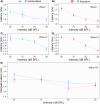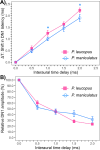This is a preprint.
Auditory Brainstem Responses in Two Closely Related Peromyscus Species (Peromyscus leucopus and Peromyscus maniculatus)
- PMID: 39713444
- PMCID: PMC11661215
- DOI: 10.1101/2024.12.09.627419
Auditory Brainstem Responses in Two Closely Related Peromyscus Species (Peromyscus leucopus and Peromyscus maniculatus)
Update in
-
Auditory brainstem responses in two closely related Peromyscus species (Peromyscus leucopus and Peromyscus maniculatus).J Acoust Soc Am. 2025 Jun 1;157(6):4559-4572. doi: 10.1121/10.0036945. J Acoust Soc Am. 2025. PMID: 40548895
Abstract
The genus Peromyscus has been extensively used as a model for ecological, behavioral, and evolutionary studies. We used auditory brainstem responses (ABRs), craniofacial morphology, and pinna measurements to compare characteristics that could impact the threshold, amplitude, and latency of ABRs in two wild-caught species, P. leucopus and P. maniculatus. We observed significant differences in craniofacial and pinna attributes between species, with P. leucopus exhibiting larger features and bigger overall size compared to P. maniculatus. ABR recordings showed similar hearing thresholds with peak sensitivity between 8 to 46 kHz for both species. We found that amplitude of ABR wave I and IV increased significantly with increasing intensity, while no main effect of species was detected. Latency of wave I and IV significantly decreased with increasing intensity in both species. Finally, we observed longer latencies of the binaural interaction component (BIC) at longer interaural time differences (ITDs) in P. leucopus, while no differences were observed across relative BIC amplitude between species. These results provide additional ABR related data that expands the use of both Peromyscus species as future models for auditory research.
Keywords: Auditory brainstem recording; Binaural hearing; Interaural timing difference (ITD); Peromyscus; Pinna.
Conflict of interest statement
COMPETING INTERESTS The authors declare no competing interests.
Figures






Similar articles
-
Auditory brainstem responses in two closely related Peromyscus species (Peromyscus leucopus and Peromyscus maniculatus).J Acoust Soc Am. 2025 Jun 1;157(6):4559-4572. doi: 10.1121/10.0036945. J Acoust Soc Am. 2025. PMID: 40548895
-
Variation in head and pinna morphology of preserved Peromyscus spp. specimens and implications for auditory function.J Anat. 2025 Jul 2. doi: 10.1111/joa.70011. Online ahead of print. J Anat. 2025. PMID: 40600245
-
Intravenous magnesium sulphate and sotalol for prevention of atrial fibrillation after coronary artery bypass surgery: a systematic review and economic evaluation.Health Technol Assess. 2008 Jun;12(28):iii-iv, ix-95. doi: 10.3310/hta12280. Health Technol Assess. 2008. PMID: 18547499
-
Chronic Electro-Acoustic Stimulation May Interfere With Electric Threshold Recovery After Cochlear Implantation in the Aged Guinea Pig.Ear Hear. 2024 Nov-Dec 01;45(6):1554-1567. doi: 10.1097/AUD.0000000000001545. Epub 2024 Jul 12. Ear Hear. 2024. PMID: 38992863 Free PMC article.
-
Systemic pharmacological treatments for chronic plaque psoriasis: a network meta-analysis.Cochrane Database Syst Rev. 2021 Apr 19;4(4):CD011535. doi: 10.1002/14651858.CD011535.pub4. Cochrane Database Syst Rev. 2021. Update in: Cochrane Database Syst Rev. 2022 May 23;5:CD011535. doi: 10.1002/14651858.CD011535.pub5. PMID: 33871055 Free PMC article. Updated.
References
-
- Arnold: The auditory brainstem response - Google Scholar, n.d.
-
- Bates D., Mächler M., Bolker B., Walker S., 2014. Fitting Linear Mixed-Effects Models using lme4. 10.48550/ARXIV.1406.5823 - DOI
Publication types
Grants and funding
LinkOut - more resources
Full Text Sources
